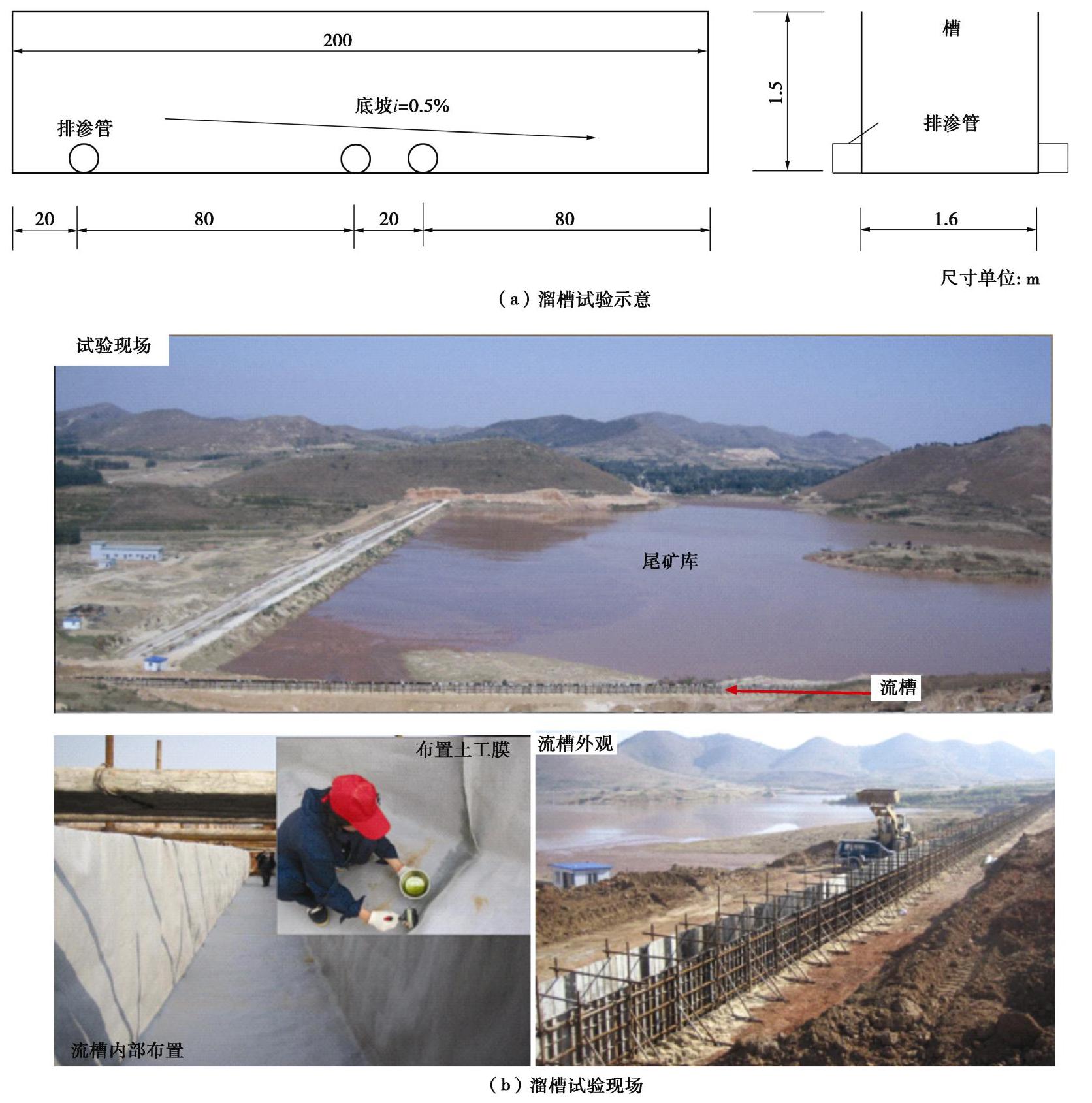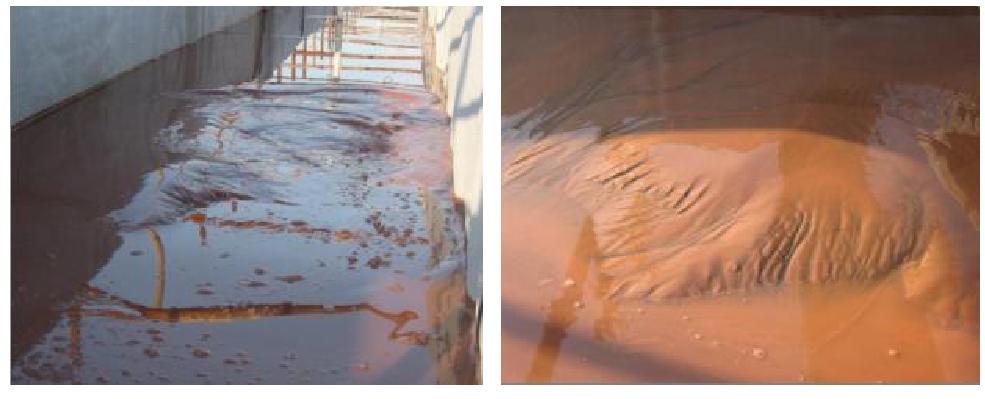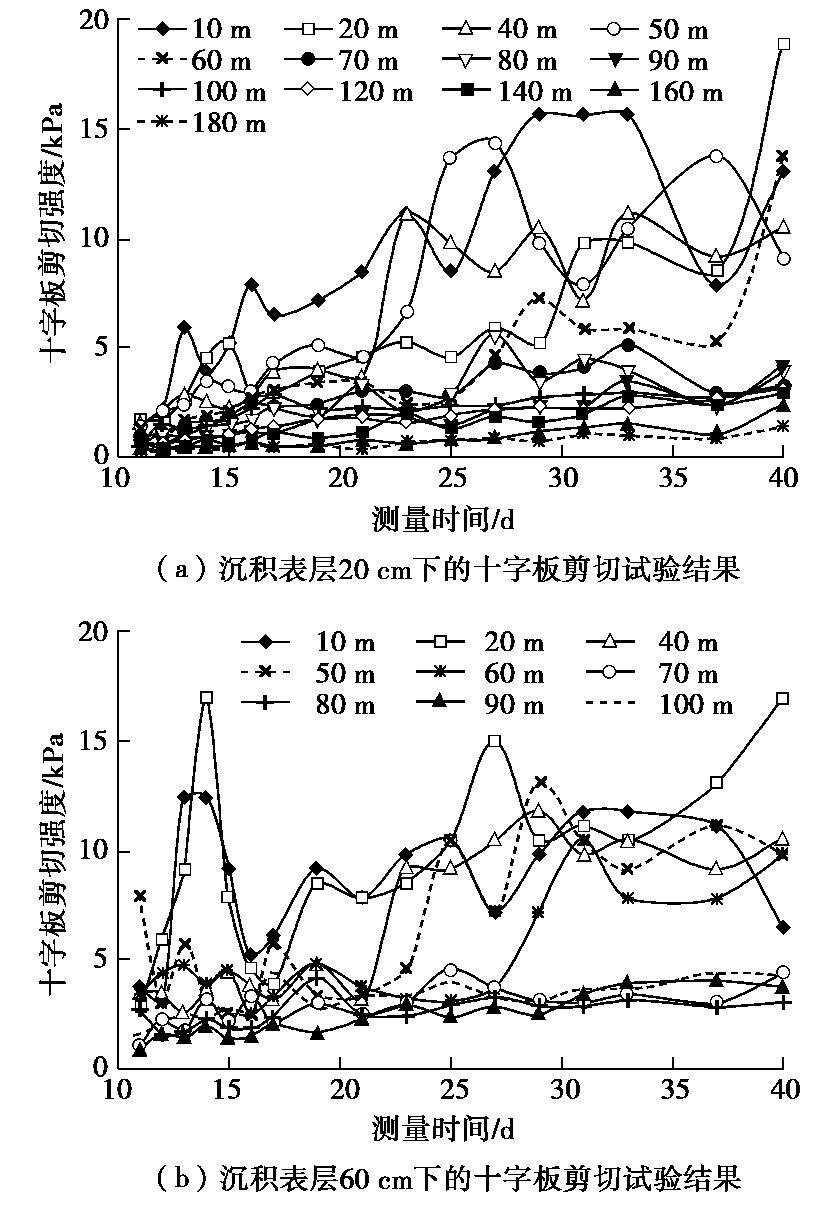Experimental study on sedimentary behavior and basic physical mechanical properties of fine iron tailings
-
摘要: 尾矿的沉积与固结过程是形成强度和确定变形量的重要依据。为探求尾矿沉积过程中应力和孔隙水压力演变规律,揭示尾矿料的强度形成机理和变形特征,结合现场溜槽试验,对细粒铁尾矿的沉积坡度、以及沉积过程中的应力、孔隙水压力和有效应力的演变规律进行了监测。同时,采用十字板剪切仪确定了沉积完成后尾矿的剪切强度。在此基础上,对不同沉积断面尾矿料的颗粒级配和渗透特性进行了试验研究,分析尾矿沉积速率的演变机理。试验结果表明:颗粒研磨极其均匀的尾矿料的堆积形式和渗透特性与尾矿料的水力特性存在差别;受尾矿颗粒相对密实度较大、颗粒分布均匀等因素影响,增加尾矿料的可透水边界较施加外荷载,更能提升尾矿料中有效应力的形成速率;尾矿料表层硬化和封闭微孔隙引发了上层滞水入渗困难,应采用必要的引水导流措施降低高势能流体对筑坝稳定性的影响。Abstract: The process of deposition and consolidation of fragmented multiphase materials is the basis and prerequisite for studying their strength and deformation. To find out the evolution laws of stress and pore water pressure during the deposition of fine iron tailings and reveal the strength formation mechanism and deformation characteristics of tailings reservoir, the sedimentary slope of tailings, stress, pore water pressure and effective stress during the deposition process are monitored by field large-scale flume tests. Meanwhile, the shear strength of tailings after deposition is determined by the vane shear apparatus. On this basis, grain-size distribution and permeability characteristics of tailings from different sedimentary sections are tested to analyze the evolution mechanism of tailings sedimentation rate. The experimental results show that the accumulation form and permeability characteristics of tailings with extremely uniform particle grinding are different from those of soils. Due to the large proportion of tailings particles and uniform distribution of particles, increasing the permeable boundary of tailings can improve the formation rate of effective stress of tailings better than applying external loads. The surface hardening of tailings and the sealing of micro-pore trigger the formation of effective stress in tailings. It is difficult to infiltrate the stagnant water in the upper layer. Necessary diversion measures should be adopted to reduce the influences of high potential fluid on the stability of dam construction.
-
Keywords:
- fine iron tailings /
- flume test /
- deposition characteristic /
- pore water pressure /
- shear strength
-
0. 引言
随着中国交通行业的不断发展,中国桥梁建设水平得到大幅提升,对桥梁跨越能力的要求也不断增长,悬索桥作为所有桥型中跨越能力最大的桥型,越来越成为跨越大江、大河的主要解决方案。但是随着悬索桥跨度的不断增加,锚碇规模急剧扩大,造成锚碇建设成本过高。因此研究锚碇沉井基础的受力变形特性对于悬索桥的锚碇优化设计显得尤为重要。
Alampalli[1]在1994年研究了沉井在承受竖向和水平向荷载时的结构响应;李永盛[2]和李家平等[3]分别在1995年和2005年通过模型试验探讨了沉井基础的变形机制和破坏失稳形式;穆保岗等[4]在2017年通过模型试验研究了水平荷载长期作用下沉井变位的特性;Liu等[5]在2019年通过模型试验结合数值模拟分析研究了重力式锚碇的稳定性。
本文首先进行了在分级水平荷载下的沉井在砂箱中的模型试验,然后基于PLAXIS 3D软件建立了有限元模型,并分析了沉井的位移及沉井前侧和沉井底部的土压力,研究了水平荷载条件下沉井的受力变形规律。
1. 依托工程及模型试验
本文依托南京仙新路大桥北锚碇沉井工程,沉井长度为70 m,宽度为50 m,高度为49.5 m。该工程地基土以粉砂和中砂为主。
本试验采用的模型槽平面尺寸为4.0 m×2.0 m,高1.0 m。地基土采用中砂,其相对密度为2.68,最大孔隙比0.881,最小孔隙比0.463,不均匀系数3.89,曲率系数0.92。模型试验分层填筑地基土,控制每层填土的厚度为0.1 m,最终得到地基土的干密度为1.55 g/cm3,含水率0.63%,相对密实度为59.61%,内摩擦角为34.5°(快剪)。
沉井模型平面尺寸为0.7 m×0.5 m,高0.495 m,由厚度为22 mm的钢板焊接而成,试验过程将沉井看成刚体,不考虑沉井自身的变形,为模拟沉井与土体相互作用的界面,通过在沉井表面黏2~3 mm的砂粒实现[6],如图1所示。
模型试验中设计荷载为62kg,本文中水平荷载分级施加,每级荷载为设计荷载的~0.5倍,试验过程中每级荷载施加持续15 min直至土体破坏(土体破坏表现为沉井盖板处的位移急剧增大),沉井加载示意图如图2所示。
2. 有限元分析
本研究建立的有限元模型完全基于模型试验,土体及沉井的单元形状均为四面体十节点实体单元,数值模型的网格如图3所示。
砂土的本构模型采用土体硬化(HS)模型,土层参数[7]取值见表1。
表 1 土层参数Table 1. Soil parameters土层 γ /(kN·m-3)e Es /MPaErefoed /MPaEref50 /MPaErefur /MPac′ φ′ /(°)ψ /(°)m 砂土 15.6 0.723 10.2 10.2 10.2 30.6 0 34.5 0 0.5 注: γ 为砂土的重度;e 为砂土的孔隙比;Es 为砂土的压缩模量;Erefoed 为砂土的主固结加载切线刚度;Eref50 为砂土的标准三轴排水试验割线刚度;Erefur 为砂土的卸载重加载刚度;c′ 为砂土的有效黏聚力;φ′ 为砂土的有效摩擦角;ψ 为砂土的膨胀角;m 为砂土的刚度应力水平相关幂值。3. 试验结果与有限元结果对比
3.1 沉井顶部位移
在沉井盖板顶部设置3个位移测量点A、B、C。在位移测量点上放置位移靶标,采用TH-ISM-ST机器视觉测量仪对靶标位移进行测量,分辨率为0.01 mm,靶标布置如图4。
模型试验和数值模拟的位移对比如图5所示,由图易知,模型试验和数值模拟的靶标位移较为一致,本文中取水平位移随设计荷载增加而不断增加的线弹性阶段为水平承载力极限值[4],即安全系数取值为4。
3.2 沉井前侧壁土压力随施加荷载变化
在沉井前侧设置8个土压力盒,布置如图6所示,由于土压力盒对称分布,且沉井左右侧完全对称,因此取沉井左右两侧土压力盒平均值作为最终结果,结果如图7所示,其中模型试验中3号及3'号土压力盒数据较差,本文中已舍弃,余下的沉井前侧土压力盒数据和数值模拟结果较吻合。
3.3 沉井前侧壁土压力随施加荷载变化
在沉井底部设置12个土压力盒,布置如图8所示,同理,取沉井左右两侧土压力盒平均值作为最终结果,结果如图9所示,其中8号及8'号土压力盒数据较差,本文中已舍弃,余下的沉井底部土压力盒数据和数值模拟结果对比,发现当施加荷载/设计荷载的值小于等于4时较一致,当其值大于4之后,二者的结果相差较大。
4. 结论
本文在已有的研究基础上,通过开展模型试验和数值模拟计算,得到水平荷载下沉井的受力变位特性,主要得出以下结论:
(1)对锚碇沉井基础在砂土中的受力变位特性进行了试验研究和有限元分析,结果显示,水平荷载下锚碇沉井基础在砂土中的破坏模式为倾覆破坏,且安全系数远大于2,说明现阶段规范[8]中锚碇设计较为保守,有进一步的优化空间。
(2)通过PLAXIS 3D软件建立了锚碇沉井基础的有限元模型,采用应变硬化的本构模型,结果表明模型试验的结果和有限元模型计算的结果较为一致,说明数值建模过程中的土体本构模型及参数取值可靠,表明PLAXIS 3D软件能够较好的模拟锚碇沉井在砂土中的受力变形行为。
上述模型试验和有限元分析,只是针对水平荷载条件下锚碇沉井基础在砂土中的受力特性开展的研究,只考虑了单层干砂的地基土层,尚需更近一步探索。
-
表 1 试验过程中各阶段
Table 1 Schedule of flume tests on tailings
序号 时间 事项 1 2011年10月13日 开始排放尾矿 2 2011年10月13日 初始阶段放矿 3 2011年10月14日—15日 第二阶段放矿 4 2011年10月16日—17日 第三阶段放矿 5 2011年10月23日—24日 第四阶段放矿 6 2011年11月08日 降雨 7 2011年11月20日 监测到尾矿冻结 8 2011年12月10日 停止数据监测 表 2 不同断面处尾矿料的颗粒组成
Table 2 Grain composition of different sections
断面/m 土粒相对密实度 颗粒组成/% 不均匀系数Cu 曲率系数Cc 液限含水率/% 塑限含水率/% 塑性指数Ip 土质类型 2~0.5 mm 0.5~0.25 mm 0.25~0.075 mm 0.075~0.005 mm <0.005 mm 5 2.877 0.24 6.69 28.13 64.70 0.25 4.47 0.57 11.68 21.55 9.87 低液限尾粉土 10 2.851 0.36 9.36 35.86 53.92 0.50 4.56 1.07 13.26 23.17 9.91 低液限尾粉土 20 2.846 0.06 4.61 39.56 54.68 1.10 4.42 1.00 13.30 22.77 9.47 低液限尾粉土 40 2.838 0.02 2.54 25.34 71.90 0.21 3.53 1.07 14.49 25.80 11.31 低液限尾粉质黏土 50 2.861 0.02 0.45 23.28 75.86 0.40 3.94 1.08 15.76 27.80 12.04 低液限尾粉质黏土 60 2.839 0.01 0.24 14.60 84.40 0.75 2.87 0.89 14.57 25.73 11.16 低液限尾粉质黏土 70 2.806 0.02 0.25 15.74 82.50 1.50 3.57 1.29 12.32 25.99 13.67 低液限尾粉质黏土 80 2.868 0 0.37 12.27 86.66 0.70 3.50 1.59 14.54 25.85 11.31 低液限尾粉质黏土 90 2.864 0 0.22 13.89 84.19 1.70 3.15 0.95 15.36 26.23 10.87 低液限尾粉质黏土 100 2.877 0 0.16 11.31 86.04 2.50 4.11 0.97 15.57 27.42 11.85 低液限尾粉质黏土 120 2.884 0 0.42 5.72 91.66 2.20 3.08 0.90 17.09 27.23 10.14 低液限尾粉质黏土 140 2.878 0 0.10 5.84 91.57 2.50 3.61 0.79 16.61 29.05 12.44 低液限尾粉质黏土 表 3 不同断面处尾矿料的渗透系数
Table 3 Permeability coefficient of different sections
断面位置/m 土粒相对密实度 干密度/(g·cm-3) 最大干密度/(g·cm-3) 最优含水率/% 渗透系数/(cm·s-1) 5 2.88 1.513 1.878 14.5 8.85×10-5 15 2.84 1.517 1.868 15.5 2.63×10-4 25 2.84 1.553 1.915 13.7 6.02×10-5 40 2.84 1.498 1.795 15.9 3.28×10-4 80 2.87 1.475 1.828 15.8 1.27×10-4 120 2.89 1.516 1.819 16.7 7.75×10-5 表 4 各测试点土样的基本物性参数
Table 4 Basic physical properties of soil samples at different test points
取土点/m 颗粒相对密实度 天然含水率/% 天然密度/(g·cm-3) 10 2.83 27.4 2.032 20 2.84 27.8 2.027 40 2.84 27.0 1.985 60 2.84 27.7 1.965 70 2.85 23.1 1.939 80 2.87 32.9 1.960 90 2.86 26.6 1.984 100 2.87 27.8 1.922 -
[1] 张力霆, 齐清兰, 李强, 等. 尾矿库坝体溃决演进规律的模型试验研究[J]. 水利学报, 2016, 47(2): 229-235. https://www.cnki.com.cn/Article/CJFDTOTAL-SLXB201602013.htm ZHANG Li-ting, QI Qing-lan, LI Qiang, et al. Experimental model study on dam break and evolution law of tailings pond[J]. Journal of Hydraulic Engineering, 2016, 47(2): 229-235. (in Chinese) https://www.cnki.com.cn/Article/CJFDTOTAL-SLXB201602013.htm
[2] 张力霆. 尾矿库溃坝研究综述[J]. 水利学报, 2013, 44(5): 594-600. https://www.cnki.com.cn/Article/CJFDTOTAL-SLXB201305015.htm ZHANG Li-ting. Summary on the dam-break of tailing pond[J]. Journal of Hydraulic Engineering, 2013, 44(5): 594-600. (in Chinese) https://www.cnki.com.cn/Article/CJFDTOTAL-SLXB201305015.htm
[3] 陈生水. 尾矿库安全评价存在的问题与对策[J]. 岩土工程学报, 2016, 38(10): 1869-1873. https://www.cnki.com.cn/Article/CJFDTOTAL-YTGC201610020.htm CHEN Sheng-shui. Problems and countermeasures of safety evaluation of tailing pond[J]. Chinese Journal of Geotechnical Engineering, 2016, 38(10): 1869-1873. (in Chinese) https://www.cnki.com.cn/Article/CJFDTOTAL-YTGC201610020.htm
[4] 孙从露, 邵龙潭, 郭晓霞. 尾矿砂不同频率动三轴试验研究[J]. 矿业研究与开发, 2015, 35(11): 69-73. https://www.cnki.com.cn/Article/CJFDTOTAL-KYYK201511017.htm SUN Cong-lu, SHAO Long-tan, GUO Xiao-xia. Study on dynamic triaxial tests of tailings sand under different vibration frequencies[J]. Mining Research and Development, 2015, 35(11): 69-73. (in Chinese) https://www.cnki.com.cn/Article/CJFDTOTAL-KYYK201511017.htm
[5] 于斯滢, 邵龙潭, 刘士乙. 基于有限元极限平衡法的尾矿坝坝体稳定分析[J]. 岩土力学, 2013, 34(4): 1185-1190. YU Si-ying, SHAO Long-tan, LIU Shi-yi. Stability analysis of tailings dam based on finite element limit equilibrium method[J]. Rock and Soil Mechanics, 2013, 34(4): 1185-1190. (in Chinese)
[6] 刘建民, 邱月, 郭婷婷, 等. 饱和重塑黄土液化孔压增长模型的试验研究[J]. 科学技术与工程, 2019, 19(19): 226-232. LIU Jian-min, QIU Yue, GUO Ting-ting, et al. Experimental study on pore pressure growth model of saturated remolded loess sample during liquefaction[J]. Science Technology and Engineering, 2019, 19(19): 226-232. (in Chinese)
[7] GARING C, CHALENDAR J A D, VOLTOLINI M, et al. Pore-scale capillary pressure analysis using multi-scale X-ray micromotography[J]. Advances in Water Resources, 2017, 104: 223-241.
[8] 刘叔灼, 李慧子, 单毅, 等. 基于能量法的尾矿土动孔压模型研究[J]. 岩土工程学报, 2016, 38(11): 2051-2058. https://www.cnki.com.cn/Article/CJFDTOTAL-YTGC201611019.htm LIU Shu-zhuo, LI Hui-zi, SHAN Yi, et al. Energy method for analyzing dynamic pore water pressure model for tailing soil[J]. Chinese Journal of Geotechnical Engineering, 2017, 104: 223-241. (in Chinese) https://www.cnki.com.cn/Article/CJFDTOTAL-YTGC201611019.htm
[9] 巫尚蔚, 杨春和, 张超, 等. 尾矿浆沉积室内模拟试验[J]. 工程科学学报, 2017, 39(10): 1485-1492. https://www.cnki.com.cn/Article/CJFDTOTAL-BJKD201710004.htm WU Shang-wei, YANG Chun-he, ZHANG Chao, et al. Indoor scale-down test of tailings[J]. Chinese Journal of Engineering, 2017, 39(10): 1485-1492. (in Chinese) https://www.cnki.com.cn/Article/CJFDTOTAL-BJKD201710004.htm
[10] 刘洋, 赵学同, 吴顺川. 快速冲填尾矿库静力液化分析与数值模拟[J]. 岩石力学与工程学报, 2014, 33(6): 1158-1168. https://www.cnki.com.cn/Article/CJFDTOTAL-YSLX201406009.htm LIU Yang, ZHAO Xue-tong, WU Shun-chuan. Analysis of static liquefaction and numerical simulation for tailings pond under high deposting rates[J]. Chinese Journal of Rock Mechanics and Engineering, 2014, 33(6): 1158-1168. (in Chinese) https://www.cnki.com.cn/Article/CJFDTOTAL-YSLX201406009.htm
[11] LIANG W, XIONG D S. Research on the solution to coefficient of earth pressure at rest using effective stress spade[J]. Journal of Railway Engineering Society, 2017, 34(7): 5-9, 35.
[12] 罗战友, 夏建中, 龚晓南, 等. 考虑孔压消散的静压单桩挤土位移场研究[J]. 岩石力学与工程学报, 2014, 33(增刊1): 2765-2772. https://www.cnki.com.cn/Article/CJFDTOTAL-YSLX2014S1025.htm LUO Zhan-you, XIA Jian-zhong, GONG Xiao-nan. Study of compacting soil displacements around jacked single pile based on excess pore pressure dissipation[J]. Chinese Journal of Rock Mechanics and Engineering, 2014, 33(S1): 2765-2772. (in Chinese) https://www.cnki.com.cn/Article/CJFDTOTAL-YSLX2014S1025.htm
[13] 郑彬彬. 高浓度尾矿上游式堆坝基础性问题研究及坝体稳定性分析[D]. 重庆: 重庆大学, 2017. ZHENG Bin-bin. Research on the Basic Issues for Upstream Method of High Thickened Tailings and Stability Analysis of Tailings Dam[D]. Chongqing: Chongqing University, 2017. (in Chinese)
[14] 张鹏伟, 吴辉, 胡黎明, 等. 铁矿尾矿料力学特性及坝体变形稳定性研究[J]. 工程地质学报, 2015, 23(6): 1189-1195. https://www.cnki.com.cn/Article/CJFDTOTAL-GCDZ201506025.htm ZHANG Peng-wei, WU Hui, HU Li-ming, et al. Mechanical characteristics of iron mine tailing materials and analysis on deformation and stability of tailing dam[J]. Journal of Engineering Geology, 2015, 23(6): 1189-1195. (in Chinese) https://www.cnki.com.cn/Article/CJFDTOTAL-GCDZ201506025.htm
[15] 成词峰, 徐颖, 郑庭. 混合式堆坝尾矿料的基本性能及沉积规律分析[J]. 青岛理工大学学报, 2018, 39(2): 36-41. https://www.cnki.com.cn/Article/CJFDTOTAL-QDJG201802008.htm CHENG Ci-feng, XU Ying, ZHENG Ting. Properties of tailings and the law of deposition about tailings dam constructed by upstream and centerline methods[J]. Journal of Qingdao University of Technology, 2018, 39(2): 36-41. (in Chinese) https://www.cnki.com.cn/Article/CJFDTOTAL-QDJG201802008.htm
[16] 尹光志, 张千贵, 魏作安, 等. 孔隙水运移特性及对尾矿细观结构作用机制试验研究[J]. 岩石力学与工程学报, 2012, 31(1): 71-79. https://www.cnki.com.cn/Article/CJFDTOTAL-YSLX201201011.htm YIN Guang-zhi, ZHANG Qian-gui, WEI Zuo-an, et al. Experimental study of migration characteristics of pore water and its effect on meso-structure of tailings[J]. Chinese Journal of Rock Mechanics and Engineering, 2012, 31(1): 71-79. (in Chinese) https://www.cnki.com.cn/Article/CJFDTOTAL-YSLX201201011.htm
[17] 魏作安, 杨永浩, 赵怀军, 等. 小打鹅尾矿库尾矿堆积坝稳定性研究[J]. 东北大学学报(自然科学版), 2016, 37(4): 589-593. https://www.cnki.com.cn/Article/CJFDTOTAL-DBDX201604028.htm WEI Zuo-an, YANG Yong-hao, ZHAO Huai-jun, et al. Stability of tailings dam of Xiaodae Tailings pond[J]. Journal of Northeastern University(Natural Science), 2016, 37(4): 589-593. (in Chinese) https://www.cnki.com.cn/Article/CJFDTOTAL-DBDX201604028.htm
[18] 冯彦芳, 李顺群, 陈之祥, 等. 基于土体各向异性的雨水入渗渗井试验研究与验证[J]. 长江科学院院报, 2019, 36(3): 110-115. https://www.cnki.com.cn/Article/CJFDTOTAL-CJKB201903022.htm FENG Yan-fang, LI Shun-qun, CHEN Zhi-xiang, et al. Experimental study and verification of rainwater infiltration well based on soil anisotropy[J]. Journal of Yangtze River Scientific Research Institute, 2019, 36(3): 110-115. (in Chinese) https://www.cnki.com.cn/Article/CJFDTOTAL-CJKB201903022.htm
[19] 李顺群, 贾红晶, 王杏杏, 等. 轴平移技术在基质吸力测控中的局限性和误差分析[J]. 岩土力学, 2016, 37(11): 3089-3095, 3252. https://www.cnki.com.cn/Article/CJFDTOTAL-YTLX201611007.htm LI Shun-qun, JIA Hong-jing, WANG Xing-xing, et al. Limitation and error analysis of axis translation technique for measuring and controlling matric suction[J]. Rock and Soil Mechanics, 2016, 37(11): 3089-3095, 3252. (in Chinese) https://www.cnki.com.cn/Article/CJFDTOTAL-YTLX201611007.htm
[20] 王建州, 刘书幸, 周国庆, 等. 深季节冻土地区基坑工程水平冻胀力试验研究[J]. 中国矿业大学学报, 2018, 47(4): 815-821. https://www.cnki.com.cn/Article/CJFDTOTAL-ZGKD201804015.htm WANG Jian-zhou, LIU Shu-xing, ZHOU Guo-qing, et al. Model experiment on frost-heave force of foundation pit at deepseasonal frozen regions[J]. Journal of China University of Mining & Technology, 2018, 47(4): 815-821. (in Chinese) https://www.cnki.com.cn/Article/CJFDTOTAL-ZGKD201804015.htm
[21] 蔡正银, 李小梅, 韩林, 等. 考虑级配和颗粒破碎影响的堆石料临界状态研究[J]. 岩土工程学报, 2016, 38(8): 1357-1364. https://www.cnki.com.cn/Article/CJFDTOTAL-YTGC201608001.htm CAI Zheng-yin, LI Xiao-mei, HAN Lin, et al. Critical state of rockfill materials considering particle gradation and breakage[J]. Chinese Journal of Geotechnical Engineering, 2016, 38(8): 1357-1364. (in Chinese) https://www.cnki.com.cn/Article/CJFDTOTAL-YTGC201608001.htm
[22] ONO K, YU Y, SAWADA Y, et al. Lateral force–displacement prediction for buried pipe under different effective stress condition[J]. International Journal of Geotechnical Engineering, 2017(2): 1-9.
[23] CHUN L I, ZHAO F L, XIU Z G, et al. Testing investigation on effective stress increment of unsaturated sandy soils[J]. Journal of Northeastern University, 2017, 38(8): 1158-1162.
[24] 张常光, 赵均海, 朱倩. 非饱和土抗剪强度公式分类及总结[J]. 建筑科学与工程学报, 2012, 29(2): 74-82. https://www.cnki.com.cn/Article/CJFDTOTAL-XBJG201202016.htm ZHANG Chang-guang, ZHAO Jun-hai, ZHU Qian. Classification and summary of shear strength formulae for unsaturated soils[J]. Journal of Architecture and Civil Engineering, 2012, 29(2): 74-82. (in Chinese) https://www.cnki.com.cn/Article/CJFDTOTAL-XBJG201202016.htm
[25] 陈星欣, 白冰, 于涛, 等. 粒径和渗流速度对多孔介质中悬浮颗粒迁移和沉积特性的耦合影响[J]. 岩石力学与工程学报, 2013, 32(增刊1): 2840-2845. https://www.cnki.com.cn/Article/CJFDTOTAL-YSLX2013S1033.htm CHEN Xing-xin, BAI Bing, YU Tao, et al. Coupled effects of particle size and flow rate on characteristics of particle transportation and deposition in porous media[J]. Chinese Journal of Rock Mechanics and Engineering, 2013, 32(S1): 2840-2845. (in Chinese) https://www.cnki.com.cn/Article/CJFDTOTAL-YSLX2013S1033.htm




 下载:
下载:














